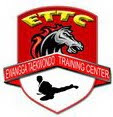The history of taekwondo has been a matter of contention. Taekwondo organizations officially state that taekwondo was derived from earlier Korean martial arts.[4][5][6][7][8][9] Others state that taekwondo is derived from native Korean martial arts with influences from neighboring countries[10][11][12][13][14] or that it was primarily derived from karate learned by Koreans during the Japanese occupation.[15][16][17]
The oldest Korean martial art was an amalgamation of unarmed combat styles developed by the three rival Korean kingdoms of Goguryeo, Sillaand Baekje.[18] Young men were trained in unarmed combat techniques to develop strength, speed, and survival skills. The most popular of these techniques was subak, with taekkyeon being the most popular of the segments of subak.
Those who demonstrated strong natural aptitude were selected as trainees in the new special warrior corps, called the Hwarang. It was believed that young men with a talent for the liberal arts may have the grace to become competent warriors. These warriors were instructed in academics as well as martial arts, learning philosophy, history, a code of ethics, and equestrian sports. Their military training included an extensive weapons program involving swordsmanship and archery, both on horseback and on foot, as well as lessons in military tactics and unarmed combat using subak. Although subak was a leg-oriented art inGoguryeo, Silla's influence added hand techniques to the practice of subak.
During this time a few select Sillan warriors were given training in Taek Kyon by the early masters fromKoguryo. The Taek Kyon trained warriors then became known as the Hwarang. The Hwarang set up a military academy for the sons of royalty in Silla called Hwarang-do, which means "The way of flowering manhood." The Hwarang studied Taek Kyon, history, Confucian Philosophy, ethics, Buddhist Morality, and military tactics. The guiding principles of the Hwarang warriors were:
- loyalty,
- filial duty,
- trustworthiness,
- valor,
- justice.
The makeup of the Hwarang-do education was based on the Five Codes of Human Conduct written by a Buddhist scholar, fundamental education, Taek Kyon and social skills. Taek Kyon was spread throughout Korea because the Hwarang traveled all around the peninsula to learn about the other regions and people.
In spite of Korea's rich history of ancient and traditional martial arts, Korean martial arts faded into obscurity during the Joseon Dynasty. Korean society became highly centralized under Korean Confucianism and martial arts were poorly regarded in a society whose ideals were epitomized by its scholar-kings.[19] Formal practices of traditional martial arts such as subak and taekkyeon were reserved for sanctioned military uses. However folks practice of taekkyeon as a kicking game still persisted into the 19th century. There are many associations of Taekwon-do, including (not limited to) the ITF, ITA, WTF, WTA, and the ATA.[18]
[edit]Modern Development
The Japanese occupation of Korea formally began in 1910, under repression of all facets of Korean identity including folk culture, language and history.[20] Koreans were forced to take Japanese names and to worship at Shinto shrines; Korean-language newspapers and magazines were banned; and during the war, hundreds of thousands of Koreans were forced into service to support Japanese war efforts.[21] Martial arts such astaekkyeon (or subak) were also prohibited during this time;[22] however, taekkyeon survived through underground teaching and folk custom.[4][23][24][25] During the occupation the few Koreans who were able to study in Japan were exposed to Japanese martial arts in some cases receiving black belts[26]. Others were exposed to martial arts in China and Manchuria.[27][12][28]
When the occupation ended in 1945, Korean martial arts schools (kwans) began to open in Korea under various influences. [12][29] There are differing views on the origins of the arts taught in these schools. Some believe that they taught martial arts that were based primarily upon the traditional Korean martial arts taekkyon and subak[4][6][29][30], or upon a variety of martial arts such as taekkyon, kungfu and karate.[31] Others believe that these schools taught arts that were almost entirely based upon karate.[32][33]
In 1952, at the height of the Korean War, there was a martial arts exhibition in which the kwans displayed their skills. In one demonstration, Nam Tae Hi smashed thirteen roof tiles with a forefist punch. Following the demonstration, South Korean President Syngman Rhee instructedChoi Hong Hi to introduce the martial arts to the Korean army.[34]
By the mid-1950s, nine kwans had emerged. Syngman Rhee ordered that the various schools unify under a single system. The name "taekwondo" was either submitted by Choi Hong Hi, or Song Duk Son of Chung Do Kwan and was accepted on April 11, 1955. As it stands today, General Choi is the founder of Taekwondo. [35] The Korean Taekwondo Association (KTA) was formed in 1961 to facilitate the unification.[6] Shortly thereafter, taekwondo made its début worldwide. Standardization efforts in South Korea stalled, as the kwans continued to teach differing styles. Another request from the Korean government for unification resulted in the formation of the Korea Tae Soo DoAssociation, which changed its name back to the Korean Taekwondo Association in 1965 following a change of leadership.
Currently, Taekwondo is practiced in 188 countries with over 70 million practitioners and 4 million individuals with black belts throughout the world. [36] It is now one of only two Asian martial arts that are included in the Olympic Games; it became a demonstration event starting with the 1988 games in Seoul, and became an official medal event starting with the 2000 games in Sydney.


0 komentar:
Posting Komentar